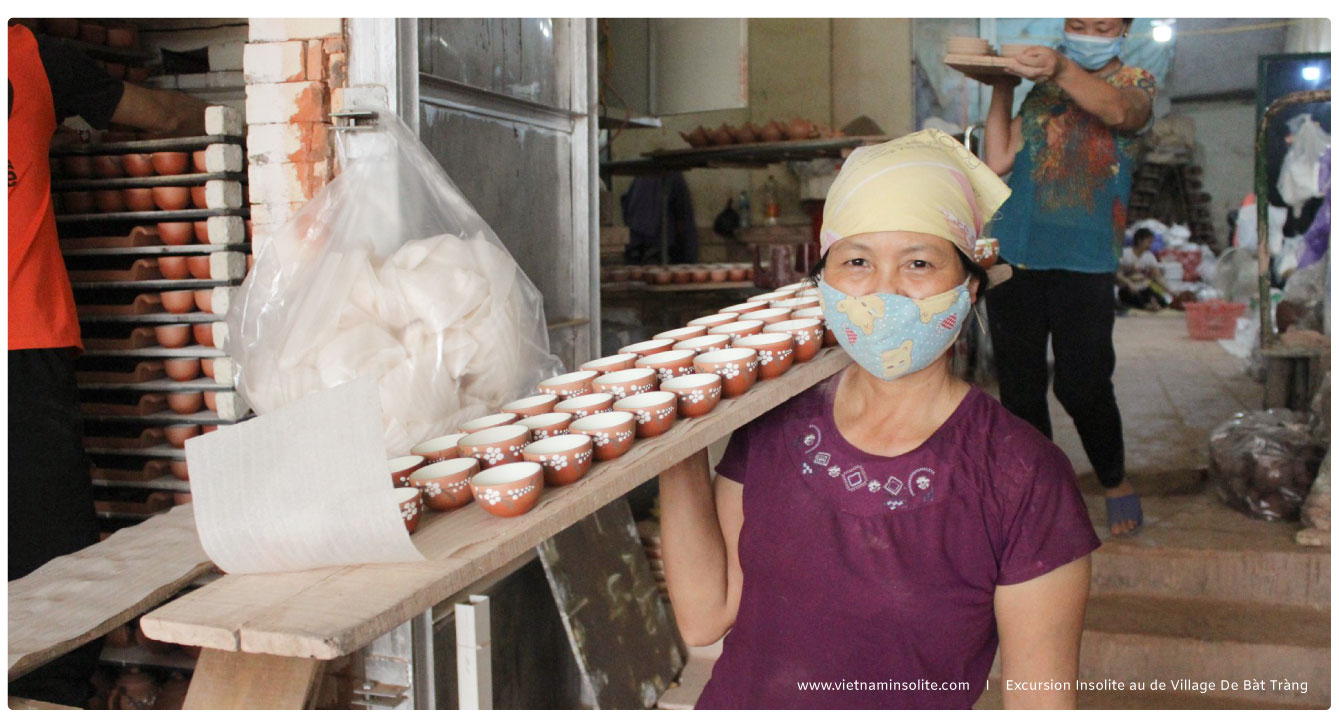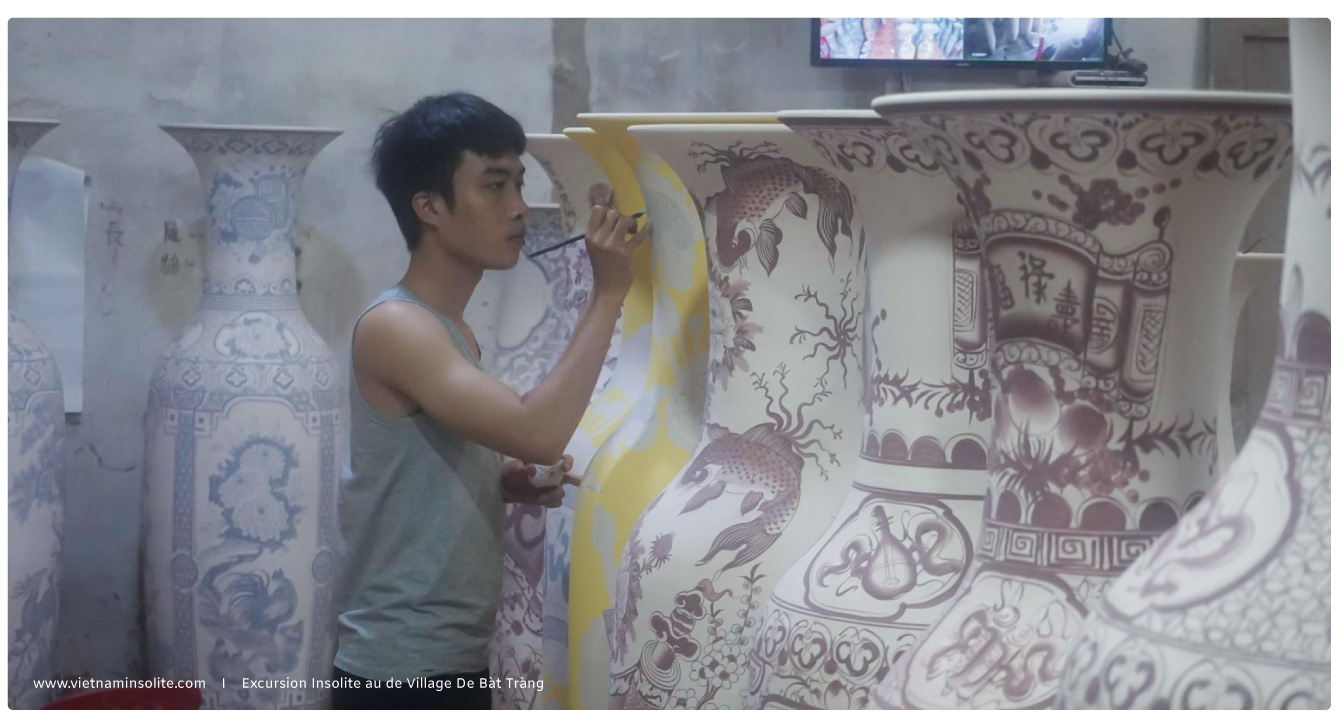
Hanoi And Its Surroundings: The Village Of Bát Tràng
If the urban air doesn’t appeal to you, you can easily find some enriching escapes around Hanoi. The capital is surrounded by several hundred artisan villages dedicated to preserving centuries-old craftsmanship. One of them, close to our hearts (we have two tea enthusiasts on the team), is Bát Tràng, the ceramic village. Let us tell you its story and introduce you to its activities. Perhaps by the end of this article, you’ll decide to leave the urban hustle and bustle behind for the tranquility of the countryside.
Bát Tràng, the Ceramic Village
Why visit?
Let’s get to the heart of the matter. This village is a cultural treasure. It allows you to immerse yourself in one of our most precious arts, ceramics, but not only that. Its winding streets, workshops scattered here and there, and its communal organization—every detail invites you to understand how our society functioned in the past. Incidentally, to our knowledge, there’s no better place in northern Vietnam to get a high-quality, authentic souvenir. In short, Bát Tràng offers an enriching visit filled with peace that will, to be honest, stretch your budget* if you have a genuine interest in fine ceramics. *There’s something for every taste and budget, don’t worry!

An Exceptional Historical Heritage
Welcome to Vietnam’s oldest ceramic village. For six centuries now, this village has worked tirelessly to preserve the art of Vietnamese ceramics. In fact, it is the national keeper of this tradition with nearly 600 active kilns. To understand its significance, let’s talk a little about Vietnamese ceramics. Although the beginnings of ceramics in Vietnam date back to the prehistoric era, the art flourished during the 11th century. This was a crucial period: Vietnam had just freed itself from Chinese rule, and the Lý dynasty had ascended to the throne, making Thăng Long (now Hanoi) the capital of the kingdom. With this newfound freedom, Vietnam was able to assert its identity in various fields, including ceramics! The rise of Vietnamese pottery was well underway, but it wasn’t until three centuries later (in the 15th century) that the people of Bát Tràng built the first kiln in the village. Located on the outskirts of the country’s major cities and at the heart of trade routes, Bát Tràng honed its fame through a few spins on the potter’s wheel, playing a fundamental role in the creation of a Vietnamese stylistic identity. This long quest for affirmation bore fruit, as Vietnamese ceramics became one of the country’s commercial pillars, finding buyers throughout Asia (and still attracts strong international interest today). Why such success? Talent and, above all, a lot of ingenuity. Vietnamese ceramics distinguished itself with the variety of its forms and pigments, the quality of its glazes, and the sophistication of its patterns. You must have seen the famous white porcelains with blue motifs depicting landscapes, people, flowers, and birds. As for inspirations, Buddhism played a major role, but not exclusively. Vietnamese ceramics evolved and diversified over the centuries, influenced by historical movements. The conquest of the Champa kingdom brought Hindu touches, while the arrival of the French introduced Western influences.

Logistical Information How to visit the village?
If the question is how to visit the village in the best way, we recommend engaging Son Nguyen, the founder of the agency, a former guide, a tea enthusiast, and a big admirer of the village. Seriously, choosing to be accompanied by a guide for this excursion is far from trivial. Why? The village is a maze of narrow streets, and the most interesting kilns and artisans are not always easy to access. From personal experience, I had the opportunity to meet and assist the last family still producing a very specific traditional teapot, thanks to Son, and as a result, I acquired one of my most cherished items without paying the European price. You’ll get the advantage of entering the workshops and interacting directly with the artisans, who will gladly show you their craft processes. It’s also an opportunity to learn more about the Vietnamese communal organization and traditions. In short, a guided tour gives the visit an entirely different dimension! If you prefer to go independently, we recommend taking every small street, peeking into every open door to see what’s happening inside! You’ll also find workshops offering pottery-making or painting pre-molded objects. If you’re with young children, this is a fun activity (I did it at 25 and thoroughly enjoyed it). For shopping, there’s a central square (unmissable) with small stalls. You can also buy directly from the workshops or in some more discreet stores. It’s in the latter that you’re more likely to find traditional pieces produced in very small, handmade batches.
How to get there?
Note that half a day is sufficient to explore the village and its narrow streets. Considering this, you have two options to get there:
Early in the morning if you want to return to Hanoi for lunch / Early afternoon if you prefer to return for dinner in Hanoi. You can:
- Take bus No. 47 to Bát Tràng from the Long Biên stop (5000 VND).
- Take a taxi or motorbike taxi (prices vary depending on the time).
So, what do you think?
We hope these few lines have sparked your curiosity about Bát Tràng and Vietnamese ceramics. Caught up in the lively memories of my last trip to the village, I forgot to mention the museum! Yes, the village houses a museum dedicated to celebrating the centuries-old traditions preserved by the local artisans. You can’t miss it; its architecture speaks for itself 😉 If you have any questions, don’t hesitate to contact us at contact@vietnaminsolite.com, and your email will be directly forwarded to Son, we promise.
If you have any questions or would like us to organize your trip, please contact Vietnam Insolite !
Leave a comment and let’s chat :)






